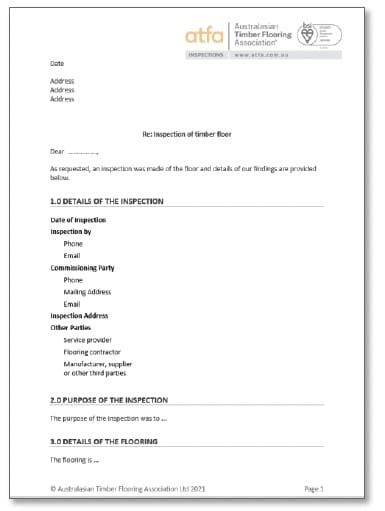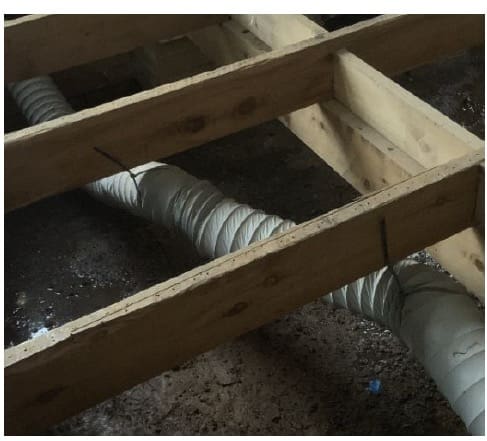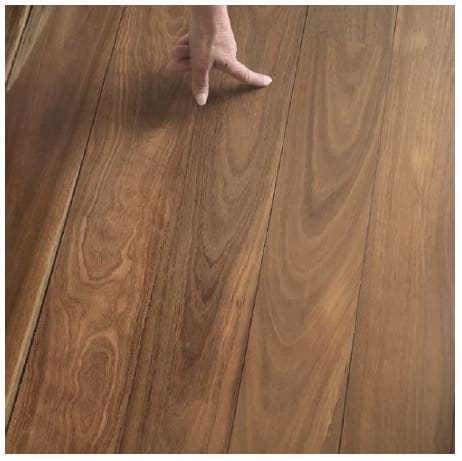You may already have read ATFA Information Sheet #3 which outlines what to do if you have a concern with your timber or hybrid floor. One option is to engage an ATFA Accredited Inspector and have your flooring concern inspected and reported on. You now have your report. This information sheet discusses the structure of the ATFA report and the options you have regarding it.
The structure of the ATFA report
You will notice that the report structure is the same irrespective of where you live and that it has the following elements to it.
1.0 INSPECTION DETAILS u2013 This simply outlines the details of the involved parties. That is the party commissioning the report, where the inspection took place, the service provider and details of product suppliers.
2.0 INSPECTION PURPOSE u2013 The purpose expresses what the inspector has been specifically asked to assess. At times, the inspector will clarify this with commissioning party.
3.0 FLOORING DETAILS u2013 This section includes information about the flooring, subfloor, fixing and coating of the product as applicable.

4.0 FLOORING HISTORYu00a0u2013 There are some aspects that are needed regarding the past history of the floor with aspects being reported by the owner, contractor, manufacturer or others as may be relevant. Mostu00a0inspectionsu00a0will need the following considered: Details of the dwelling; When the floor was laid; What product or site checks were made prior to installation; When the floor was sanded and coated; What the condition of the floor was on handover; When the owner first observed concerns; How the floor may have changed.
5.0 FLOORING SKETCH u2013 The sketch orientates the reader to the dwelling and where concerns may lie with the floor. Often moisture meter readings and measurement over ten boards will be included. With these added to the sketch, differences in floor performance and/or appearance, along with the location of these differences can be easily visualised.
6.0 OBSERVATIONS, MEASUREMENTS & PHOTOS u2013 This section of the report provides the evidence behind the inspectoru2019s findings. It contains statements and general observations of both site and floor, photos, measurements, and test data. Photographs provide visual evidence of the floor, with each photo being referenced by a number and then commented on. The photos take the reader in a systematic way through the inspection. The first photo may be of the dwelling (if important) and then followed by a photo giving an overall view of the floor and photos focusing on concerns. The section may also contain tables relating to the data collected such as moisture meter readings and measurements of the boards.
7.0 ANALYSIS u2013 In this section, what the inspector has seen and assessed through photographic evidence, measurements and readings, is analysed to say what the gathered information means. It is therefore the data and photographic evidence that is assessed against industry requirements that determines the validity of the concerns with the floor. Standards and other reference information is also used to assist with explanations and assessment.
8.0 CONTRIBUTING FACTORS u2013 The analysis section can become quite detailed. This section is provided to focus and summarise the main aspects of the analysis. That is those factors that have contributed to the problem or concern. It is often presented in dot point form and is quite brief.
9.0 REMEDIAL OPTIONS u2013 There are often a number of aspects to be considered if remediation is necessary. Hence options are provided that can be considered by involved parties. Although generally not specific in nature they still provide good guidance and direction.

10.0 CONCLUSIONS u2013 The conclusion to the report is simply a summary of the report and
generally includes:-
- The purpose
- A summary of the concerns
- A summary of the contributing factors
- A summary of the remediation that may be needed
The inspection report is peer reviewed prior to providing it to the inspectoru2019s client. Inspections are impartial in nature with the inspector not being an advocate of any party. Should the ATFA conflict of interest policy indicate known conflict, the inspection would be diverted to another inspector.
Using the ATFA report
ATFA inspections cover a wide range of concerns that are generally associated with a flooru2019s appearance or performance. This can relate to how products are performing, the suitability of the environment in which the floor is installed, an assessment of the subfloor on which the flooring has been installed, or the quality and manner in which the floor was installed or finished. In other instances, the floor may have become water affected, and a need to evaluate the extent of damage.
With many of the problems that occur there is more than one contributing factor. Reports seek to identify and comment on each factor, including its contribution toward the problem. The report will explain the reasons behind why the problem or problems have occurred, and thereby facilitate a path where involved parties can work toward resolution. The degree of works that may be needed to be provided and options available to achieve a commercially acceptable result are also provided. There can also be the situation when the report indicates that no remedial work is necessary or where it can be prudent to wait, as some floor problems can be transitional and correct themselves.
It should be noted that a commercially acceptable floor is not an imperfection free floor, but where such imperfections do not dominate or severely affect the overall appearance or performance of the floor. Various standards accept varying levels of imperfections in floors.

Reports may therefore be used to:
Provide direction on repairs or works needed to facilitate repairs
There are many examples of this, including many inspections undertaken for the insurance industry. An example of this would be determining if a repair or replacement is necessary on a water damaged floor. Similarly, the report would assess the extent of damage and where possible, identify damage to the floor that may have been pre-existing. Comment is also at times made on past practices and whether they comply with current practices.
Provide an avenue to assist in mediation directly between parties
At times concerns arise when the expectations of one party differ to that of another over the works that have been completed. This may relate to the quality of products used, the installation methods used, or also sanding and coating imperfections. An example may be where dark stains occur on a floor due to pet urine and where the new coating is more susceptible to such staining. Or it could relate to larger gapping at board edges near a wood fired heater. With cases such as these, owners may not have been provided with adequate information, or their own practices may have been a significant contributor. A floor may also have some squeaks present and as some squeaking in floors can be expected, the report would identify whether such squeaking was considered acceptable or excessive and in need of remedial work. Such assessments being cognisant of dwelling, products, installation practices, degree and location of the problem and what industry documentation considers.
Provide a report for tribunal purposes, if still not resolved
There are a limited number of cases where agreement cannot be reached as to who is responsible to correct a problem in a floor. If it is at this stage prior to the inspection being organised, then the u2018if intended for tribunal or courtu2019 box on the ATFA Request for Inspection form (RFI) should have been ticked. The inspector will then include some additional relevant elements to the report as required. If this is only decided on after the completion of a standard report, then the inspector would need to be contacted for an accompanying letter to cover these additional aspects required by the tribunal or court. This includes that the inspector acknowledges that their duty is to the tribunal or court and not the person who commissioned the inspection, that they have read the relevant expert code of conduct, and that they have provided their CV. In most instances an expertu2019s report will be needed by the tribunal or court.
Under these proceeding in Australia, each party will usually have their own expert and report. Prior to any hearing there will be mediation between the parties which is quite separate to a hearing. The purpose is to negotiate a resolution, which can involve one party agreeing to pay the other party a sum of money. The mediation is facilitated by the tribunal member and experts may be present. If the issue is not resolved, then a meeting is convened between the experts to determine what they do and do not agree on. It is only the matters that they do not agree on that will go to the hearing. With tribunals, lawyers may or may not be involved and it is also important to realise that costs to pay both the expert and the lawyer can mount up.
Based on the evidence provided at the hearing the tribunal member will decide on the outcome, which is often not necessarily the decision that the parties were expecting.
Final remarks
The purpose of an ATFA report is to provide clear guidance as to the nature of a concern, provide an assessment on how that is measured against Industry standards and commercial acceptability, and to provide suggestions on how the issues can be mediated. Often this clarity helps diffuse any tension between conflicted parties and clarifies a scope of works to progress the floor towards a suitable outcome. The robust nature of the reporting process (including peer reviewing and stringent inspector standards) also means that if required, ATFA reports are suitable and well respected if the matter progresses to a tribunal or court setting.
